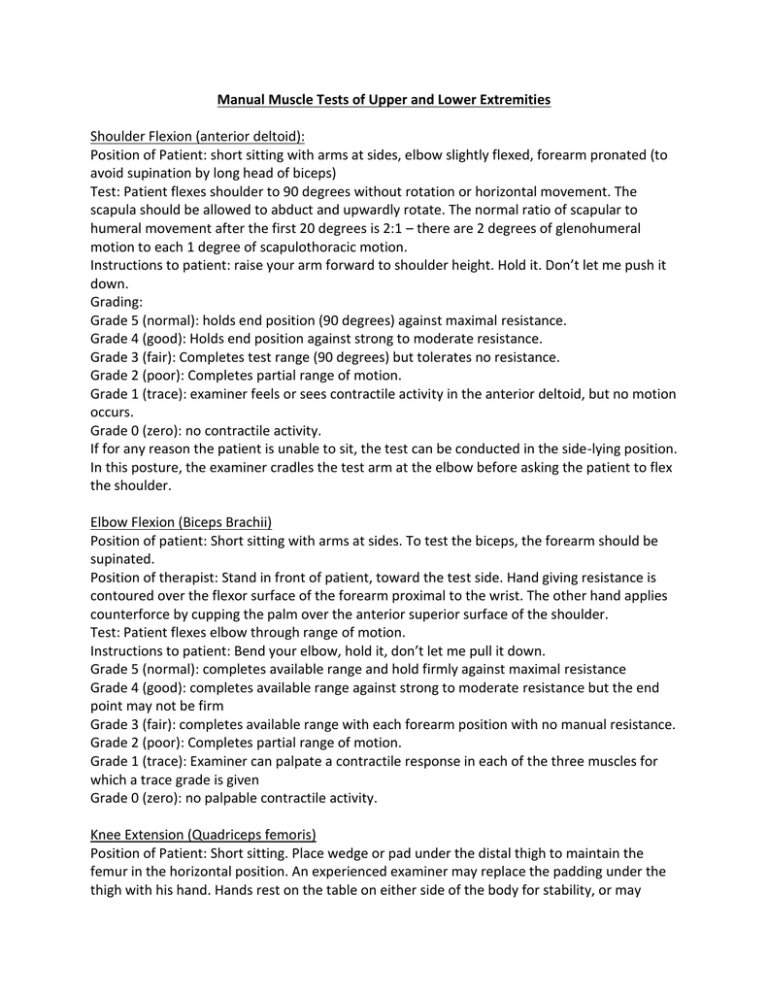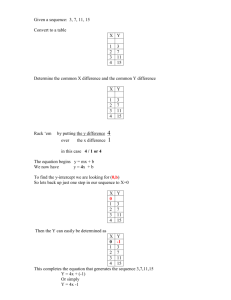File - Ms. Ward's class!
advertisement

Manual Muscle Tests of Upper and Lower Extremities Shoulder Flexion (anterior deltoid): Position of Patient: short sitting with arms at sides, elbow slightly flexed, forearm pronated (to avoid supination by long head of biceps) Test: Patient flexes shoulder to 90 degrees without rotation or horizontal movement. The scapula should be allowed to abduct and upwardly rotate. The normal ratio of scapular to humeral movement after the first 20 degrees is 2:1 – there are 2 degrees of glenohumeral motion to each 1 degree of scapulothoracic motion. Instructions to patient: raise your arm forward to shoulder height. Hold it. Don’t let me push it down. Grading: Grade 5 (normal): holds end position (90 degrees) against maximal resistance. Grade 4 (good): Holds end position against strong to moderate resistance. Grade 3 (fair): Completes test range (90 degrees) but tolerates no resistance. Grade 2 (poor): Completes partial range of motion. Grade 1 (trace): examiner feels or sees contractile activity in the anterior deltoid, but no motion occurs. Grade 0 (zero): no contractile activity. If for any reason the patient is unable to sit, the test can be conducted in the side-lying position. In this posture, the examiner cradles the test arm at the elbow before asking the patient to flex the shoulder. Elbow Flexion (Biceps Brachii) Position of patient: Short sitting with arms at sides. To test the biceps, the forearm should be supinated. Position of therapist: Stand in front of patient, toward the test side. Hand giving resistance is contoured over the flexor surface of the forearm proximal to the wrist. The other hand applies counterforce by cupping the palm over the anterior superior surface of the shoulder. Test: Patient flexes elbow through range of motion. Instructions to patient: Bend your elbow, hold it, don’t let me pull it down. Grade 5 (normal): completes available range and hold firmly against maximal resistance Grade 4 (good): completes available range against strong to moderate resistance but the end point may not be firm Grade 3 (fair): completes available range with each forearm position with no manual resistance. Grade 2 (poor): Completes partial range of motion. Grade 1 (trace): Examiner can palpate a contractile response in each of the three muscles for which a trace grade is given Grade 0 (zero): no palpable contractile activity. Knee Extension (Quadriceps femoris) Position of Patient: Short sitting. Place wedge or pad under the distal thigh to maintain the femur in the horizontal position. An experienced examiner may replace the padding under the thigh with his hand. Hands rest on the table on either side of the body for stability, or may prefer to grasp the table edge. The patient should be allowed to lean backward to relieve hamstring muscle tension. Do not allow the patient to hyperextend the knee because this may lock it into position. Position of therapist: Stand at the side of limb to be tested. The hand giving resistance is contoured over the anterior surface of the distal leg just above the ankle. Resistance is applied in a downward direction (toward the floor) in the direction of knee flexion. Test: Patient extends knee through available range of motion but not beyond 0 degrees. Grade 5 (Normal): Hold end position against maximal resistance. Most physical therapists will not be able to break the normal knee extensors. Grade 4 (good): Holds end position against strong to moderate resistance. Grade 3 (fair): completes available range and holds the position without resistance. Grade 2 (poor): completes available range of motion Grade 1 (trace): contractile activity can be palpated in muscle through the tendon. No joint movement occurs. Grade 0 (zero): No palpable contractile activity. Knee Flexion (all hamstring muscles) Position of Patient: prone with limbs straight and toes handing over the edge of the table. Test may start in about 45 degrees of knee flexion. Position of therapist: Standing next to limb to be tested. Hand giving resistance is contoured around the posterior surface of the leg just above the ankle. Resistance is applied in the direction of knee extension. The other hand is placed over the hamstring tendons on the posterior thigh (optional). Test: Patient flexes knee while maintaining leg in neutral rotation. Instructions to patient: bend your knee, hold it, don let me straighten it. Grade 5 (normal): Resistance will be maximal, and the end knee flexion position (approximately 90 degrees) cannot be broken. Grade 4 (good): End knee flexion position is held against strong to moderate resistance. Grade 3 (fair): holds end range position but tolerates no resistance. Grade 2 (poor): completes available range of motion in side-lying. Grade 1 (trace): tendons become prominent, but no visible movement occurs. Grade 0 (zero): no palpable contraction of the muscles, and tendons do not stand out. Ankle Dorsiflexion (anterior tibialis) Position of Patient: With patient sitting, the knee is flexed at 90 degrees. Position of Therapist: The therapist sits in front of testing limb and supports the leg just above the posterior aspect of the ankle joint. Test: The patient dorsiflexes the ankle joint foot without extending the great toe. Pressure is applied on the dorsum of the foot (in the direction of plantar flexion and eversion). Instructions to patient: Pull your foot up to the ceiling Grade 5 (normal): hold end position against maximal resistance Grade 4 (good): holds end position against strong to moderate resistance Grade 3 (fair): completes range of motion and holds position without resistance Grade 2 (poor): completes range of motion Grade 1 (trace): contractile activity can be palpated, no joint movement occurs Grade 0 (zero): no palpable contraction of the muscles Mnemonic to help standardize procedure: D – demonstrate and/or explain MMT position R – request the subject to assume the MMT position A – Adjust the subject’s position manually if necessary P – Place your hands on the subject to administer the MMT E – execute with verbal cues (“hold!”) and apply manual pressure




